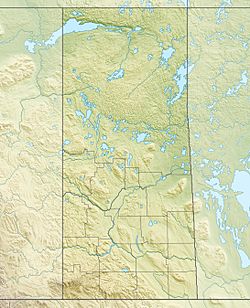Patuanak facts for kids
Patuanak is a community in northern Saskatchewan, Canada. It is home to the English River First Nation, a First Nations group. The community is located near the Churchill River and the north end of Lac Île-à-la-Crosse. In the Dene language, the name Patuanak sounds like Boni Cheri (Bëghą́nı̨ch’ërë).
Patuanak has two main parts. One part is the village, called the Northern Hamlet of Patuanak. It has about 64 residents and is led by a Mayor and two councillors. The other part is the Wapachewunak 192D reserve, which is home to the English River First Nation. This reserve has about 482 residents (from the 2011 Canada Census) and is led by a Chief and six councillors.
Patuanak is about 92 kilometers (57 miles) north of Beauval. You can reach it by following Highway 918 to its end.
Contents
Patuanak's Past: A Look at History
Patuanak is located west of the Shagwenaw Rapids on the Churchill River. The community stretches along the shoreline for about two and a half kilometers (one and a half miles). The reserve is near the open water below the rapids. Many families now living in Patuanak used to live in areas further down the Churchill River, like Primeau Lake, Dipper Lake, and Knee Lake, or near Cree Lake.
Just like in many northern communities, the Hudson's Bay Company set up a store in Patuanak. This store replaced others further down the Churchill River. This made Patuanak an important place for trading furs.
In 1916, Father Louis Moraud became the local priest in Patuanak. He served the English River Band area until he passed away in 1965. The main religion in the community is Roman Catholic.
Patuanak's permanent population stayed small for many years. However, in 1968, many people from the surrounding areas began to move into the community.
A school opened in Patuanak in 1968. This was a big reason why many families moved there. They wanted their children to be able to attend school. Before 1968, children were sent to mission schools in Beauval and Ile a la Crosse. Their families would often go north to trap furs during this time.
If you visit Patuanak, you can still see many traditional activities. People practice things like tanning moose hides, creating different kinds of beadwork, and making birch toboggans.
People from Patuanak work in many different jobs. Some work in mines, such as those at Rabbit Lake and Key Lake. Others have jobs with the government or work for the Band office.
Cross Island: A Place of Refuge
On April 27, 1885, during the North-West Rebellion, there was some trouble in the area. Many people from the Hudson's Bay Company Post and the Roman Catholic Mission of Île-à-la-Crosse were worried. They had heard about problems at the Green Lake Post the day before.
Because of this, they fled to a small wooded island north of Patuanak. The Denesuline people from the area helped them. On May 24, the people who had found refuge on the island put up a large cross. This island is now known as Cross Island 55°59′46.1″N 107°40′26.9″W / 55.996139°N 107.674139°W. They returned to Île-à-la-Crosse on May 29.
Patuanak's Population: How Many People Live Here?
In the 2021 Census, Statistics Canada counted the population of Patuanak. There were 63 people living in 28 homes. This was a small decrease of about 14% from its 2016 population of 73 people. The community covers an area of about 1.09 square kilometers (0.42 square miles).
The Wapachewunak 192D reserve is part of the English River Dene Nation. As of May 2012, the English River Dene First Nation had a total of 1,451 members. About 774 of these members lived on the reserve, while 677 members lived off the reserve.
See also
- Patuanak Airport
- Denesuline language
- Denesuline


